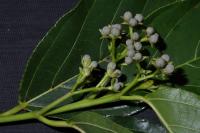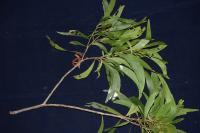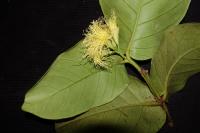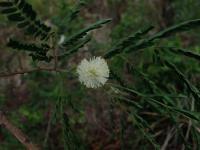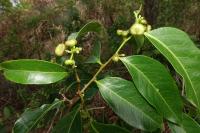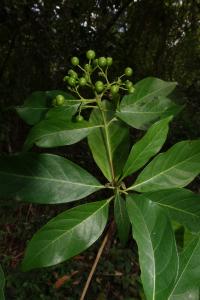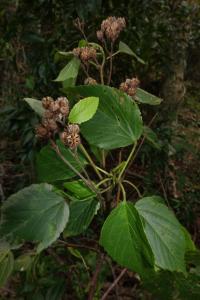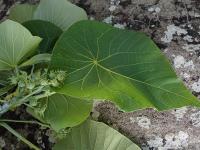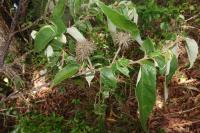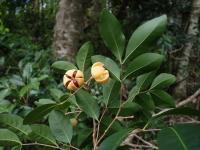Your search for * in construction / homes has returned 100 entries
inceimu
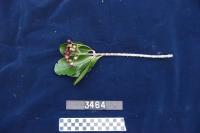
n. tree, 7 m tall (collection: Gregory M. Plunkett #3464)
Example: This is a sacred plant. The wood is used for rafters in house building. To plant taro, take an 8 cm diameter stick, sharpen it and use to make holes for planting. The stick is as long as needed for a person to stand while making the hole.
bookmarkincejev ataheñ
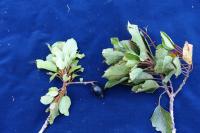
incepñekrei
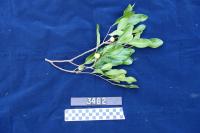
incipñekrei
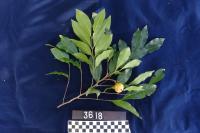
inciñyiñpa
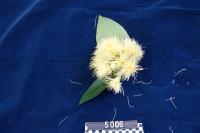
incowos
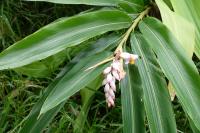
n. herb to 1. 5 m, flowers white with pink tips. Growing on sandy path along coastal walk to ute. (collection: Michael J. Balick #4989)
Example: The leaves of this plant are used to finish the ridge of the house roof. Lay the leaves horzontally on top of the roof, and the sides of the roof are thatched with palms or grass. Layer 10 leaves on top of each other to enable this part of the roof (known as nitjintiniom) to last for a long time--perhaps up to 6 years. If this is used on the top of a roof where there is a fire burning, such as a kitchen, and this leaf gets a lot of smoke, it can last much longer a the top of the roof--perhaps 10 years or more.
bookmarkinmac
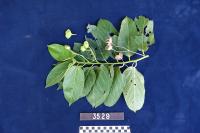
inmerei
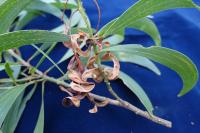
n. tree to 2 m tall,dbh 40 com (collection: Michael J. Balick #4877)
Example: To treat a local disease (that causes pain in the stomach) called "Namya," peel off the outer bark, collect 1 handful of inner bark, boil with 1/2 liter of water, drink warm, 3 cups/daily, for 3 days. At that point the person will feel that "the weakness is no longer in the body." After 3 days of treatment the pain in the stomach goes away. Wood is used for posts; leaves for compost for holes that people will plant taro in--line the bottom of the hole before placing soil and taro in it.
bookmarkinm̃aka
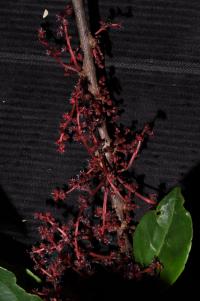
n. well branched tree, 12 m tall (collection: Gregory M. Plunkett #4022)
Example: 1. A durable hardwood that is used for house posts. 2. The wood is used to fashion cross members that affix outriggers to the body of the canoe. 3. 4-5 inch diameter saplings are used to create a track in the forest that larger logs can roll down.
bookmarkinpakanhas
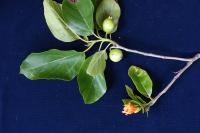
inta
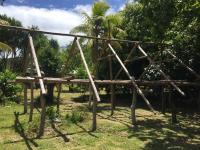
intapin
n. a hedge; a shelter
bookmarkintijgarae
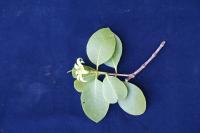
n. tree, 5 m tall (collection: Gregory M. Plunkett #3519)
Example: The stem of this plant is used for fence posts that lead to the sea, and it is resistant to salt water and lasts a long time. The wood is strong and good to make house posts. People use this wood on the coast as salt water does not bother this wood.
bookmarkintoho
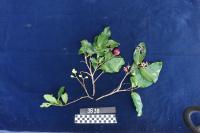
n. tree, 10-12 m tall (collection: Gregory M. Plunkett #3638)
Example: This tree is a good source of firewood, wood for house posts as well as sawn timber. The ripe fruit is edible but some of these are sour. Kids eat fruits – it is black. Pick only the most ripe fruits. This species grows commonly on river banks.
bookmarkintoutau
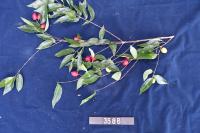
n. tree, 14 m tall (collection: Gregory M. Plunkett #3586)
Example: To make a fire, take a 1-2 cm diameter stick, sharpen it and rub it against a larger piece, ca. 6 cm in diameter. As a person rubs, the stick will start smoking and then start a fire, especially if there are a few small slivers of stem on the stick that can catch fire. People use other types of sticks to rub against the larger piece as well, and this will make a fire.
bookmarkintoutau
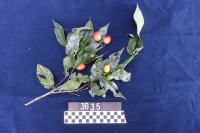
n. tree, 7-8 m tall (collection: Gregory M. Plunkett #3635)
Example: The wood from this tree is used for house posts. Used to heal bad spirits, headaches, fever, or any other kind of illness that modern medicine cannot fix. Must be taken and performed in the evening before the sun sets. Take four leaves from the top of the intoutau, netethae, nelmaha, inrowod plants. Combine them with 1/4 cup of water and squeeze the juice out of the leaves and pour into a piece of bamboo. Give the mixture to the sick person to drink. The woman must drink half of the mixture and use the other half of the mixture to wash their body with. The woman then has to stay away from other people except for those who helped wash her. Then you must smash the bamboo that contained the mixture where the sun sets.
bookmarkinwou apeñ
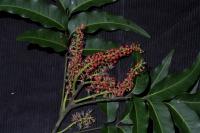
inwoudec
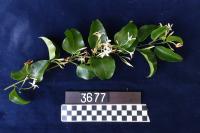
n. liana climbing on large Dillenia tree, growing in primary forest at edge of river. flower white. (collection: Gregory M. Plunkett #3677)
Example: If a person is building a temporary house and has no other way of attaching the poles, collect the vine of this species, roll it a bit to break the fiber, heat it in a figure 8 form and then use for tying poles while warm.
bookmarkinyehec
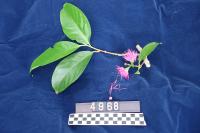
n. tree to 7 m, dbh 20 cm (collection: Michael J. Balick #4968)
Example: The fruits are edible when they are red. If a person has been drinking kava and the next morning feels hung over, they can take a handful of the leaves of this plant, crush them in cool water, and wash their face with this. This treatment will help the kava feeling to disappear. At the same time, if a person eats the fruit of this tree a few hours in advance of planning to drink kava, they cannot drink kava as it will reduce the effects of the kava. The trunk of this tree can be used to build temporary houses and also it is good for firewood. When the plant is in flower, flying foxes and birds come to drink the nectar and hunters know this so they hunt near this tree.
bookmarklakasia
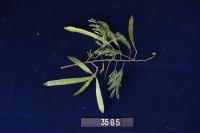
mak
adj. smooth, applied to sugarcane-leaf thatch
bookmarknaevas
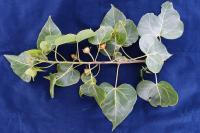
n. sparsely to moderately branched tree, 6-8 m tall (collection: Gregory M. Plunkett #3220)
Example: 1. Wood is used for carving as it is a nice black wood. 2. Also used for house posts. 3. Use sapwood – cut a piece of wood, long one 1-2 m. Put it in front of the house or take a smaller piece on top of the entrance door – protects against bad spirits.
bookmarknafanu
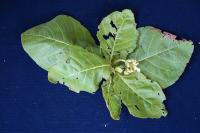
n. tree, 3-4 m tall (collection: Gregory M. Plunkett #3570)
Example: This plant grows in coastal areas, and is a good source of firewood. It can be used for house posts. The leaves are used as an unspecified medicine. There is a belief regarding the black and white sea snake, that represents a seawater spirit. Mix this with other unspecified leaves, mash together, squeeze into a bamboo tube and fill it. Give it to a woman to drink to keep the evil snake spirit away. The same preparation can be used to treat toothache, caused by the seawater spirit. "The spirit can trick you into going to fish every day."
bookmarknafanu
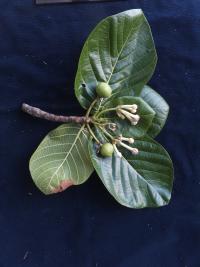
n. tree. Growing on the coast. (collection: Ashley A McGuigan #23)
Example: 1. To cure the sea snake (nispev) curse that causes missed periods. First the husband must combine 4 young leaves of incispev and 4 young leaves of nafanu and mash and squeeze the juice into a small bamboo (1-1.5 inch diameter) The nafanu is important because it is a plant that connects to the sea. Use wildcane leaves cover the bamboo closed. Go to the sick person and unwrap the snake from her. Start from the top and let the woman drink a small part of the potion then wash her with the mixture, making sure to wash head, elbows, knees, feet, and belly. Then take a leaf of naha and break it over the woman’s belly button to break the snake off. Smash the bamboo vessel to pieces. Leave the woman there until the wash dries on her. This takes one whole day and the ceremony in the evening so she can sleep and she must not eat. This ritual is performed by men. 2. Firewood, house post for bush house.
bookmarknahein
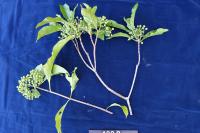
n. shrub to 1 m tall, frits green. Red clay soil (collection: Michael J. Balick #4880)
Example: Stems are used to produce cyclone houses--secure wild cane (Miscanthus) on the roof of the house. Fold cane in half over the stem of this plant and then lay it on the roof. Makes layers that resist the wind. The stem of this plant can be sharpened to make a fishing spear, or used as the shaft and a few wires are attached to the end.
bookmarknaheñ
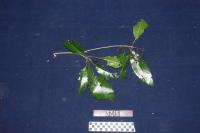
naheñ
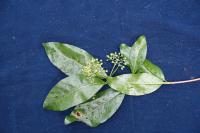
nahoj
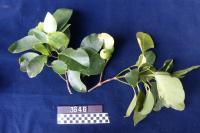
n. tree, 7 m tall (collection: Gregory M. Plunkett #3646)
Example: The ripe fruits of this species smell very nice and people eat the inside part, which tastes similar to a banana. When fruit is ripe the outside is yellow and the inside is purple. The wood can be used for poles to make house rafters. When kids go fishing for shrimps they use the fruit to catch the shrimp by throwing the shrimp into the water which attracts the shrimp.
bookmarknahoj
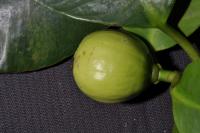
namlau
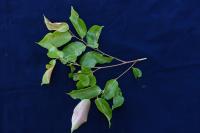
n. shrub, 2 m tall (collection: Gregory M. Plunkett #3485)
Example: 1. The larger stems of this plant can be used to build houses, for rafters. 2. It is also a good source of firewood. 3. Ancestors, before go to chief’s canal and want to talk about a complicated issue – a person would cut a branch and bring it to the sea and tap the water surface and would say what he wants, ask that he would want that issue to be solved and that others would follow his ideas and then go back to the meeting place and take stick, keep wind at his back, moving stick in all directions and then he will convince the people of his ideas. This is done by the chief’s spokesman. Helps convince the opposition. Helps keep power in hands of parent(??) chief rather than subchiefs who might have other ideas.
bookmarknamlau
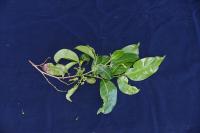
n. shrub, 2 m tall (collection: Gregory M. Plunkett #3490)
Example: 1. The larger stems of this plant can be used to build houses, for rafters. 2. It is also a good source of firewood. 3. Ancestors, before go to chief’s canal and want to talk about a complicated issue – a person would cut a branch and bring it to the sea and tap the water surface and would say what he wants, ask that he would want that issue to be solved and that others would follow his ideas and then go back to the meeting place and take stick, keep wind at his back, moving stick in all directions and then he will convince the people of his ideas. This is done by the chief’s spokesman. Helps convince the opposition. Helps keep power in hands of parent(??) chief rather than subchiefs who might have other ideas.
bookmarknamlau
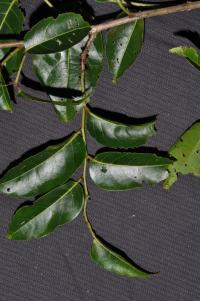
namlau or nida
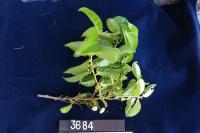
namrop̃om
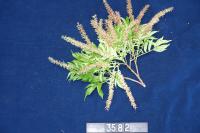
n. tree, 7-8 m tall (collection: Gregory M. Plunkett #3582)
Example: Firewood, timber good for bush houses. Calendar plant – when it is in flower, the old people know it is time to harvest root crops, like yam and other vine crops, in the wild, as yet unspecified. Local names = INYAC, NOMODEJ TAL, NOMODEJ WOU, NOU LELCEI… etc.
bookmarknanad op̃a
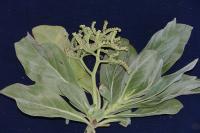
n. tree, 4-5 m tall (collection: Gregory M. Plunkett #3542)
Example: Some people use the dried leaves of this plant when there is no tobacco. Roll the leaves and smoke them. This is a good plant to lay under as a shade along the coast. Good firewood. The leaves are used with other leaves as part of a ceremony to calm the sea.* Burn leaves in a special place and toss ashes in the sea – sea will be calm.* When you are paddling to another island. Carry them with you and toss in sea as you go. Also goes with fasting and cleansing when traveling in this way.
bookmarknapod

n. tree to 10 m, dbh 30 cm (collection: Michael J. Balick #4900)
Example: Before there was soap, people took the young leaves and crushed them on a stone to make suds for washing clothes in the river. This tree has a very hard wood and can be used for house posts. The sap is reddish and the bark boiled in water until it is red, consumed 2-3 times daily (1 cup each time) until the person feels well. The condition treated is that when a menstruating woman has sex with a man, and he feels tired and lethargic, drinking this tonic makes him feel stronger.
bookmarknapojev
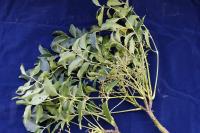
n. tree to 5 m, dbh 10 cm (collection: Michael J. Balick #4889)
Example: The leaves are used to cover meat when baking it in a stone oven (inmawum). This will soften the meat and keep it moist. Used when other species of this genus are not available, for example if you are in the bush.
bookmarknap̃od
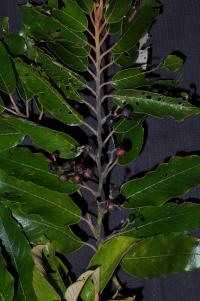
nap̃ojev
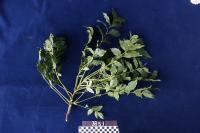
n. well branched tree, 14 m tall (collection: Gregory M. Plunkett #3651)
Example: Poles made from this plant are used for house rafters and burned for firewood. To plant taro in a swampy area, collect the leaves of this species and put them in the hole where the taro is to be planted, mix with a bit of soil and then plant the taro on top of that. Leaves are a type of fertilizer. Used when baking with the earth oven. Hot stones cover the food and then the leaves from this plant cover the stones. The leaves stay on the branch.
bookmarknap̃ojev
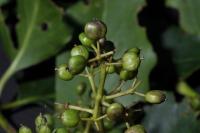
narevaro
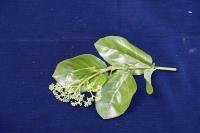
natji
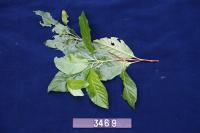
natora
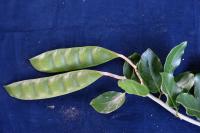
nawod
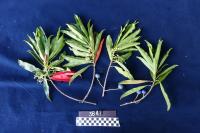
n. tree, 12 m tall (collection: Gregory M. Plunkett #3641)
Example: 1. The wood of this tree is used to make temporary houses, for example, when making a garden by the river. 2. The wood can be sawn into timber. 3. People collect red leaf and put under tongue when want to talk about conflicted issues such as a dispute to make their argument stronger.
bookmarknecñanman
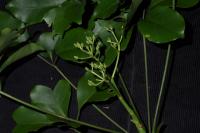
necñanman
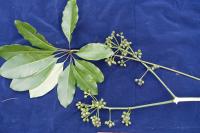
nejeg
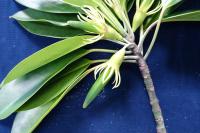
n. tree to 4 m, dbh 8 cm (collection: Michael J. Balick #4925)
Example: The wood of this tree is hard and used for house posts. It grows in the water or inundated areas, fish, crabs, sea creatures use the roots of this tree to hide and breed. People know that this tree stops big waves and therefore protect the trees.
bookmarknejeg
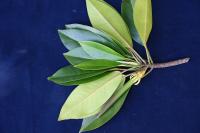
n. tree, 8 m tall (collection: Gregory M. Plunkett #3514)
Example: 1. The wood is strong and good to make house posts. People use these for this purpose on the coast as salt water does not bother this wood. 2. People eat fruit, split fruit in half, carefully scrape the inner part into a pot of water, keep over night – next day rinse, fry or cook with coconut milk and can add tinned tuna for example, very hard work.
bookmarknejeg
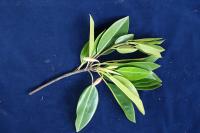
n. tree, growing in forest at edge of wide tidal stream (collection: Gregory M. Plunkett #3535)
Example: 1. The wood is strong and good to make house posts. People use these for this purpose on the coast as salt water does not bother this wood. 2. People eat fruit, split fruit in half, carefully scrape the inner part into a pot of water, keep over night – next day rinse, fry or cook with coconut milk and can add tinned tuna for example, very hard work.
bookmarknekro
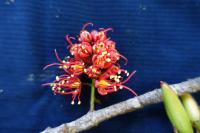
nekro
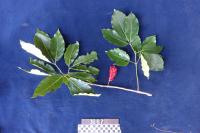
nekro
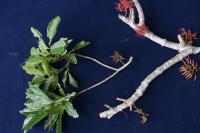
nekrolas
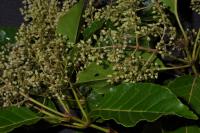
nelkap̃aeñ
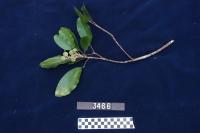
nemla
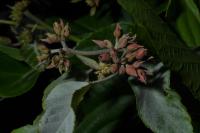
n. tree, 4 m tall (collection: Gregory M. Plunkett #4127)
Example: 1. This wood can be used to start a fire, where there are no matches. Two dried pieces of wood are rubbed vigorously together to create tinder. The tinder is then added to dried material in order to start a fire. 2. The wood of this plant is used as rafters in traditional houses.
bookmarkneroa
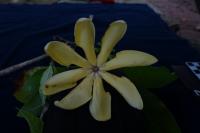
neroa
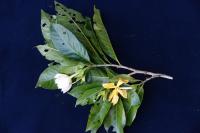
n. tree, 6 m tall (collection: Gregory M. Plunkett #3513)
Example: 1. The flower is used to make a necklace and the wood used as poles for a house roof. The flower is very fragrant and people put it behind their ear to enjoy the aroma. The leaf is used to bake taro in the earth oven. Use a fire to heat stones, then when the fire burns down and the stones are hot, pile these leaves on top of the hot stones and then place the food being cooked--taro, fish, pig, cassava, banana or other foods--on top of the leaves. Then pile more of these leaves on top of the food and then place additional hot stones on top of that pile of leaves. While the food is cooking--each type of food takes a different amount of time--the leaves give off a very nice smell and help flavor the food. 2. Firewood, flower smells good, put in coconut oil to give it aroma. Grate coconut, add small amount of water, put in bowl, heat until water is evaporated, the oil is on top, take all the coconut cream on bottom save oil in another pot. Drop 2-3 flowers into coconut oil and boil, or more flowers. Try not to burn the oil. Take out flowers and use pure oil. Also used for final covering of large earth oven during feast along with GMP 3503 – esp. wedding feast. Planting pole and hard and heavy wood – sharp end. 3. This is a "calendar plant." When it flowers, people know that the taro is ready to harvest.
bookmarkneroa
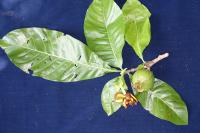
n. tree, 6-7 m tall (collection: Gregory M. Plunkett #3527)
Example: 1. The flower is used to make a necklace and the wood used as poles for a house roof. The flower is very fragrant and people put it behind their ear to enjoy the aroma. The leaf is used to bake taro in the earth oven. Use a fire to heat stones, then when the fire burns down and the stones are hot, pile these leaves on top of the hot stones and then place the food being cooked--taro, fish, pig, cassava, banana or other foods--on top of the leaves. Then pile more of these leaves on top of the food and then place additional hot stones on top of that pile of leaves. While the food is cooking--each type of food takes a different amount of time--the leaves give off a very nice smell and help flavor the food. 2. Firewood, flower smells good, put in coconut oil to give it aroma. Grate coconut, add small amount of water, put in bowl, heat until water is evaporated, the oil is on top, take all the coconut cream on bottom save oil in another pot. Drop 2-3 flowers into coconut oil and boil, or more flowers. Try not to burn the oil. Take out flowers and use pure oil. Also used for final covering of large earth oven during feast along with GMP 3503 – esp. wedding feast. Planting pole and hard and heavy wood – sharp end. 3. This is a "calendar plant." When it flowers, people know that the taro is ready to harvest.
bookmarknetcetas
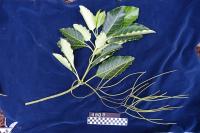
netcetas
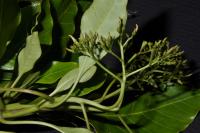
n. well branched tree, 15 m tall (collection: Gregory M. Plunkett #4084)
Example: 1. The name means "explosion". Further information about the plant withheld.
bookmarknetcetec
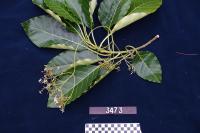
n. trees, 3-4 m tall (collection: Gregory M. Plunkett #3473)
Example: 1. This species is excellent for firewood as it gives off less smoke than other types of wood. 2. The wood is good for making roof rafters on which to tie thatch. 3. Use this for planting pole, for taro, cane, and kava.
bookmarknida
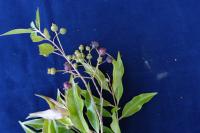
nigired
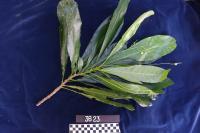
n. tree, 4 m tall (collection: Gregory M. Plunkett #3623)
Example: People use the leaf of this plant to layer on the bottom of the earth oven, and then pile food such as manioc or taro on it, then pile leaves of this species on top of that. This will help insulate the food from the high heat of the earth oven and allow it to cook better. Used especailly in feasts like weddings. Women usually collect this leaf and is used to cover very large earth ovens.
bookmarknigirid
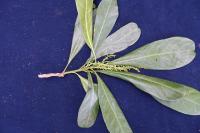
n. tree, 4 m tall (collection: Gregory M. Plunkett #3503)
Example: The leaves of this plant are used in cooking, particuarly with the earth oven. Use a fire to heat stones, then when the fire burns down and the stones are hot, pile these leaves on top of the hot stones and then place the food being cooked--taro, fish, pig, cassava, banana or other foods--on top of the leaves. Then pile more of these leaves on top of the food and then place additional hot stones on top of that pile of leaves. While the food is cooking--each type of food takes a different amount of time--the leaves give off a very nice smell and help flavor the food.
bookmarknihivaeñ aeyec
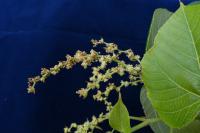
n. tree, 3 m tall (collection: Gregory M. Plunkett #3213)
Example: 1. When a person has a headache from being out in the sun too long, scrape the outer bark off of the stem of this tree, take scrapings of the inner bark, wrap with a leaf of breadfruit and put in a fire for 15-20 minutes. Not a hot fire, but only in the flame. Squeeze the water out of the bark when it is warm and rub all over the forehead and face to help the headache go away. 2. Use the stems of this tree as a stick to carry taro from the field, as the stick is strong but not too heavy. The taro is tied to each end to balance on a person’s shoulders. 3. Leaf used for wrapping local medicines. This is the best leaf and put it on the charcoal to heat it. 4. Good firewood.
bookmarknihivaeñ aeyhec
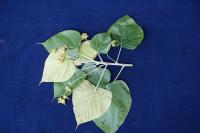
nihivaeñ p̃ap̃
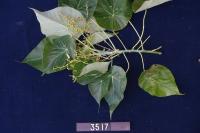
n. tree, 4 m tall (collection: Gregory M. Plunkett #3517)
Example: 1. The leaves of the young plant are used to wrap food for cooking on a fire. 2. The wood is used for temporary houses, for making rafters that are said to last a long time. 3. The wood is strong and used to carve paddles for the canoe. 4. It is also grown and used for firewood. 5. Firewood, (6) use as local plate. 7. On west side of island, take old coconut, fill with water, put lead into hole on end, take out and give to baby to drink and it will help the baby talk.
bookmarknijma
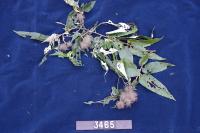
n. fallen tree, growing in canopy gap in primary forest. (collection: Gregory M. Plunkett #3465)
Example: When the flowers of this plant are green, it is an indication that the cool season is approaching; when the flowers are brown, the dry season is coming. The wood is used to make rafters for the roof of houses, on which to tie thatch.
bookmarknijwou
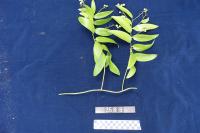
n. vine climbing up a macaranga tree, growing in open disturbed area. Fruits green. (collection: Gregory M. Plunkett #3588)
Example: 1. To build a cyclone house, take the vine of this species to tie pieces of the house. To prepare the vine for use as rope, collect many feet of it, put it in a fire, roll it in a figure 8, wait until it softens and then use for tying. This vine is hard and needs to be heated to a high temperature in the fire to make it soft; the person preparing this must use gloves to tie it to the posts and rafters while it is still warm. When it cools, it is very strong. Rope made from this vine will last a long time--perhaps 10-15 years. It can also be used to make a regular house. However, it is not as strong as GMP #3589. 2. For men who want rasta in hair, take a few leaves and dry them, burn with some other plants to rub on the rasta and keeps it healthy, keep from splitting.
bookmarknipahas
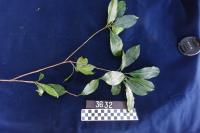
n. tree, 10. 5 m tall (collection: Gregory M. Plunkett #3632)
Example: This plant produces a very strong wood that can be used for an ax or knife handle or a handle for any type of tool. It is a good wood for house posts. It must be dried to use, but it can be dried without the use of fire. Made as with others in ancient days used to make a war club, shape with stone, heat in fire to make it strong.
bookmarknispeheñ
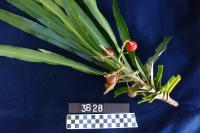
n. sparsely branched tree, 2. 5 m tall (collection: Gregory M. Plunkett #3628)
Example: This plant is used to make a grass skirt for women. There are two different methods decribed. In the first, collect the leaves, tear off 1/2 of the leaf and pleat the halves. Then dry these in the sun by hanging them from the midrib. After they are dry, weave them into a skirt. In the second, take one leaf at a time, tear the leaf down the center and throw away the midrib. The soft part is used in making the skirt by holding a piece of twine between your toes and under your armpit. Weave the length of the twine with the leaf. The let the pieces to dry in the sun for 2-3 days. The skirt can be thrown in the sea before drying to make the skirt white. Bark of inhao is usually used as twine. Retted strips of leaves, later sun dried, can be used to make pillows. When dogs or humans have fish poisoning this plant can help. Take 2 leaves and pound them (use 1 leaf for dogs) and mix with 1/4 cup of water. no further instructions given. (OR - Leaves to cure ciguatera, chew 1 leaf and swallow juice and spit out fiber. Or extract juice into a cup to drink 1x. Give juice + water in cup for dog that is sick.) There is also a belief that you can use the whole stem of this plant as a digging spade to plant sugarcane so the sugarcane is soft and sweet.
bookmarkniyeg
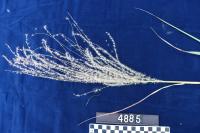
n. grass to 1. 5-2. 0 m tall, inflorescence white. Red clay soil (collection: Michael J. Balick #4885)
Example: Cut this grass in the morning, let dry for 2 days, and then use to weave the roof of a house. This is thicker and heavier than a coconut leaf. Also, use for cyclone house. (see photos of house) When indicating something is Tabu, tie the leaf and put it in an object like ripe bananas and people know it is Tabu and will not take it away.
bookmarkniyeg
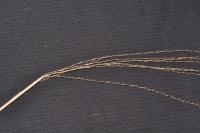
n. grass, 2. 5 m tall (collection: Gregory M. Plunkett #4071)
Example: 1. Dried leaves are used to make the thatch roofs of traditional houses. The same leaves are woven to make the walls of traditional houses. 2. When a large torch is required, many dried stems are bundled to form a flambeau. 3. The leaves of this plant are used to demarcate tabu areas. Further information about the practice withheld.
bookmarknomropom
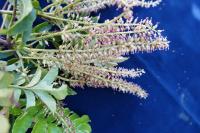
n. shrub to 2 m, flowers white (collection: Michael J. Balick #4874)
Example: This plant is an indicator of rich soil, especially up on the hills from the coast. Therefore, this is where people choose to do their gardens. This specimen is in red soil that is not rich so it does not grow tall, but in the mountains it does grow tall and that is where gardens are planted. Wood from the tree is used for carving.
bookmarknomrop̃om̃
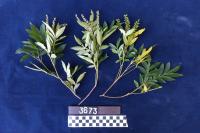
nopou
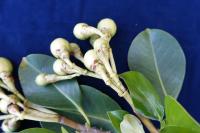
n. tree to 5 m, dbh 10 cm (collection: Michael J. Balick #4881)
Example: The wood of this tree is used to make house-posts, it is strong. The leaves are used as a compost for the taro patch; line the hole with the leaves of this tree, then place soil over that and plant the taro. When the fruits are ripe, local people say that the hermit crabs are "fat" and ready to collect and eat. When a person is in the forest and there is no coconut fruit fiber to start a fire with, use a dry stick, shave it and use a match to start a pile of this tinder to make a good fire. The wood is said to be "oily." This gives it a nice aroma. To perfume coconut oil, drop the dry flowers in it--use 1 handful of dried flowers added to a pot of oil boiling on the fire while making it. Strain out flowers and the oil smells good. Flowers can also be added to the oil once it is bottled to perfume it.
bookmarknop̃ou
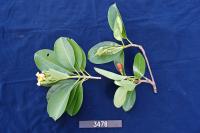
n. large epiphyte on dead tree, growing in open forest. (collection: Gregory M. Plunkett #3478)
Example: The wood of this plant is very hard and can be used for house posts. Because the wood is somewhat heavy, younger stems can be sharpened at one end and the pole can be used to plant dryland taro, to make holes for the tubers. For planting swamp taro, the leaves can be used to line the pit that the taro is planted in; it is a local fertilizer for the taro, and as it rots the soil becomes soft while the taro is growing. The flowers are placed behind one’s ear to enjoy the fragrance or can also be used to make a floral necklace (Intañ).
bookmarknop̃ou
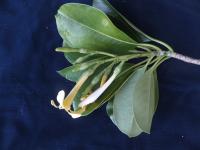
n. tree. Found in the village, usually grows in the hills. (collection: Ashley A McGuigan #16)
Example: 1. Lot of oil in the heartwood so it is good to start a fire, split it into small strips and you can light it for a fire. 2. Calendar plant – when the fruits ripen people know that this is the best season to eat the big hermit crab – meaning that they are fat.
bookmarknuae
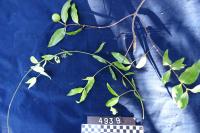
nuei
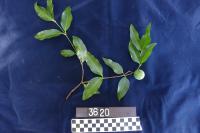
n. vine climbing into the canopy on Sarcomelicope, growing in primary rainforest. Fruits green. (collection: Gregory M. Plunkett #3620)
Example: This plant is used for local rope. Coil it in a figure 8, heat on a fire, when it is soft, use it for tying poles on a house. It is very strong when cool and dry.
bookmarknuei
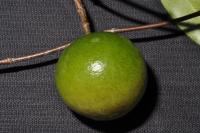
n. vine climbing up a dead tree, growing in dense rainforest. Fruits green. (collection: Gregory M. Plunkett #4056)
Example: 1. The stems are used as a traditional rope to fasten house posts. First a length of stem is coiled in a figure-eight pattern. It is then heated to render it pliable. Once heated, for several minutes, it is immediately used to fasten the posts. When cool, it is set and inflexible. Such a fastener can last 20 years.
bookmarknuei
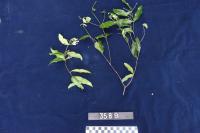
n. vine, growing in open disturbed area. Flowers white. (collection: Gregory M. Plunkett #3589)
Example: To build a cyclone house, take the vine of this species to tie pieces of the house. To prepare the vine for use as rope, collect many feet of it, put it in a fire, roll it in a figure 8, wait until it softens and then use for tying. This vine is hard and needs to be heated to a high temperature in the fire to make it soft; the person preparing this must use gloves to tie it to the posts and rafters while it is still warm. When it cools, it is very strong. Rope made from this vine will last a long time--perhaps 10-15 years. It can also be used to make a regular house.
bookmarknuei
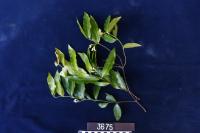
n. vine, growing up trees in primary forest at edge of river. flower white. (collection: Gregory M. Plunkett #3675)
Example: This vine is collected, rolled in a figure 8 and put on a fire to soften it and used to tie posts. It is tied when warm, because when it cools it is very strong, "like wire." It does not burn on the fire, only become soft. It is said to be excellent for the construction of cyclone houses, it shrinks after heating to make a very strong rope.
bookmarknuhujcei
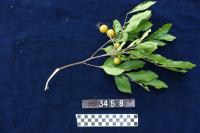
numu yehec
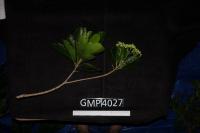
numuyehec

numuyehec
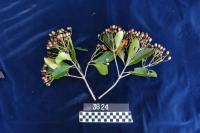
nup̃ut
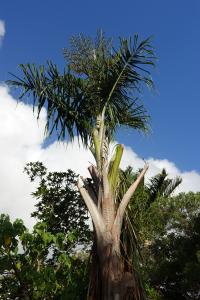
nwujvaeñ
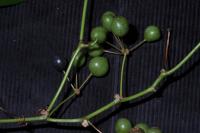
n. vine climbing up ficus wassa, growing in dense rainforest. (collection: Gregory M. Plunkett #4016)
Example: 1. The vine is use to lash roof rafters to house posts. The vine is collected from the forest and coiled ina figure 8 pattern. It is then heated over a fire before fastening the rafter to the post. 1 minute of heat is sufficient, before one immediately uses the vine.
bookmarkromo romo
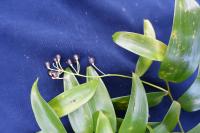
n. vine to 1 m, fruits black. Secondary forest. (collection: Michael J. Balick #4906)
bookmark
